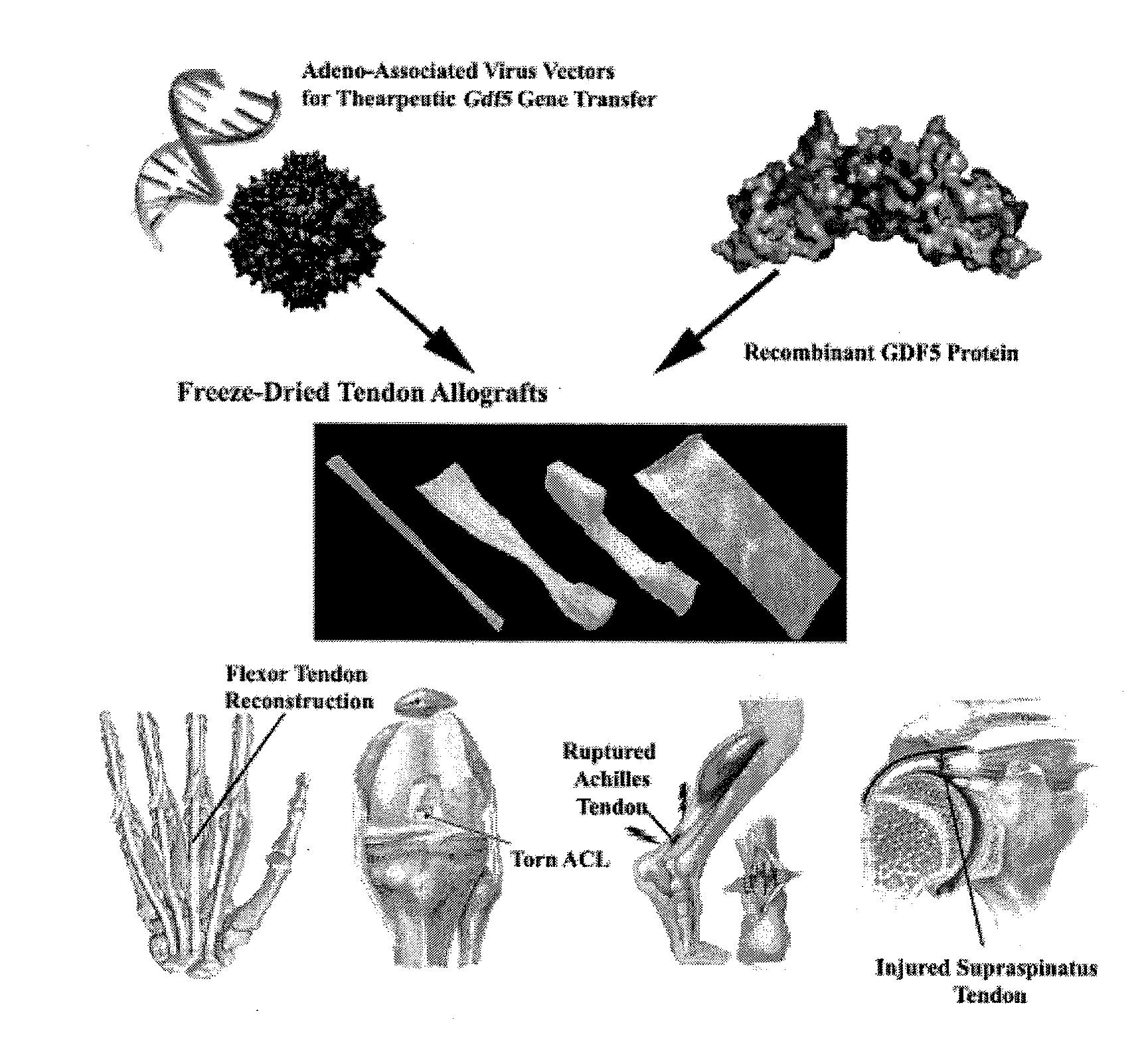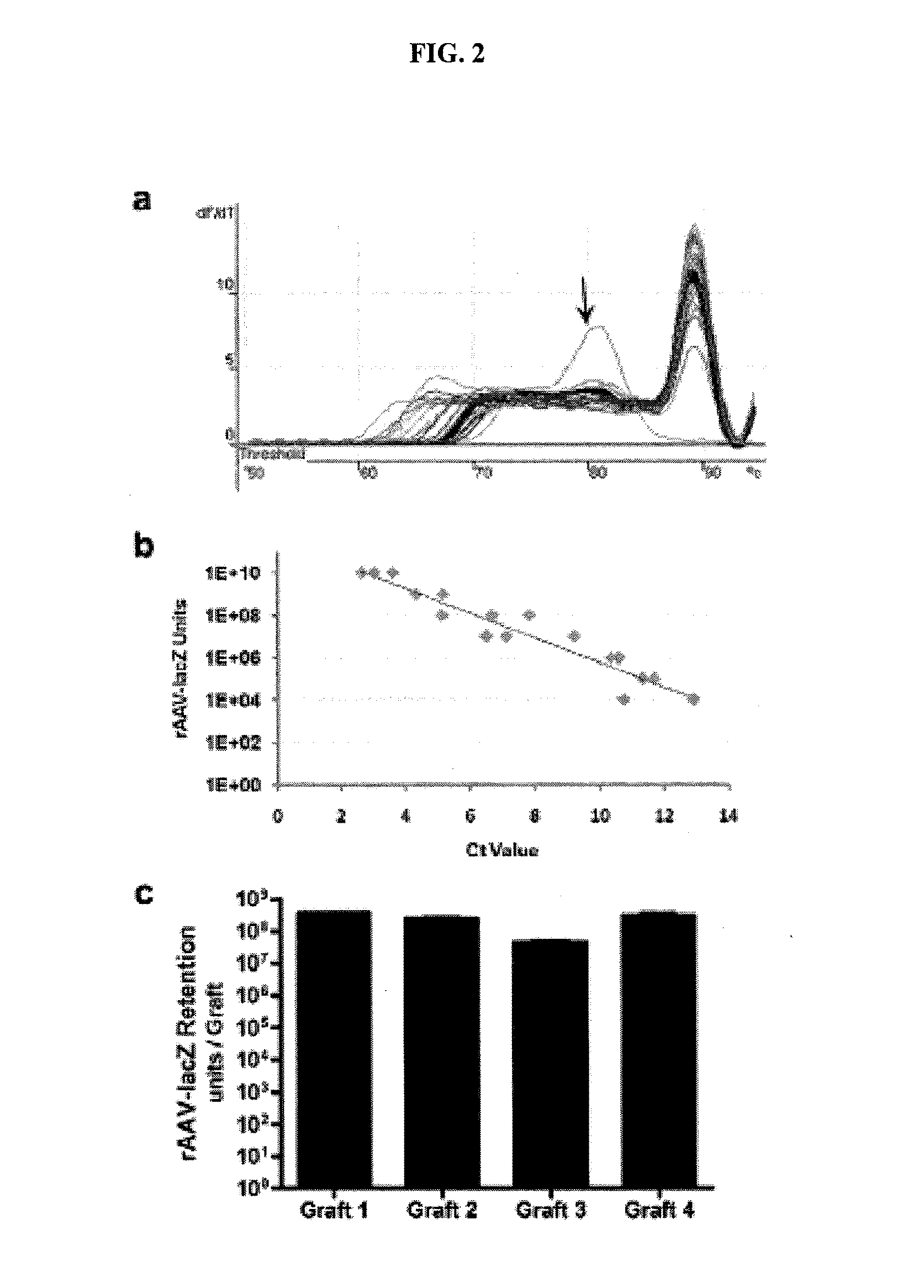Targeted delivery of therapeutic agents with lyophilized matrices
a technology of lyophilized matrices and therapeutic agents, applied in the field of gene therapy and drug delivery, can solve the problems of almost invariably significant adhesions, and achieve the effect of accelerating healing and reducing the constant healing tim
- Summary
- Abstract
- Description
- Claims
- Application Information
AI Technical Summary
Benefits of technology
Problems solved by technology
Method used
Image
Examples
example 1
A Murine Distal FDL Tendon Graft Model to Study Repair and Adhesions
[0117]To investigate the cellular, molecular, and biomechanical aspects of scarring and adhesion formation following flexor tendon grafting, a mouse distal flexor digitorum longus (FDL) tendon grafting model was developed. Briefly, the FDL tendon was isolated and a 3 mm defect created in the distal FDL on the plantar surface of the metatarsal, as shown in FIGS. 1C and 1D. An interposition freeze-dried tendon allograft or live autograft was sutured between the ends of host tendon using 8-0 nylon sutures and reconstituted with sterile normal saline. The tendon was then transected at the proximal musculotendinous junction to temporarily immobilize the flexor mechanism, which in turn prevents disruption of the tendon graft early in the repair period, and to provide a stimulus for adhesion formation. Mice were sacrificed at multiple end point times, up to 84 days post surgery, to evaluate tendon adhesion non-destructivel...
example 2
Effects of Freeze-Drying on the Biomechanical Properties of FDL Tendon Grafts
[0132]To determine whether the process of freeze-drying adversely affects the biomechanical properties of the graft material prior to implantation, the tensile failure properties of fresh frozen and freeze-dried mouse FDL tendons were determined and compared.
[0133]Briefly, mouse FDL tendons were harvested as described earlier. Tendons were either tested freshly after harvest (fresh FDL tendon; Group 1), freshly frozen at −80° C. immediately after harvest (fresh-frozen FDL tendon, Group 2), freeze-dried once in a 2 L bench-top Labconco® lyophilizer (1× freeze-dried FDL tendon; Group 3), or freeze-dried, reconstituted in saline and then freeze-dried again (2× freeze-dried FDL tendon; Group 4). For testing, the tendons were re-hydrated at room temperature in a bath of PBS and then mechanically tested in tension until failure at a rate of 30 mm / minute as described above (Seiler et al., 1993; Seiler et al., 1997...
example 3
Stability and Efficacy of the rAAV Targeted Gene Delivery in Revitalizing Bone Allografts
[0135]About 108 rAAV-LacZ units in 1 μL of virus solution were diluted in 50 μL of coating buffer containing 1% sorbitol in 0.1% buffered phosphate saline (PBS), and the mixture used to coat mouse femoral allografts, which in this example were 5 mm long. Once coated, the femoral allografts were freeze-dried. After freeze-drying and various storage times, the femoral allografts were incubated with HEK-293 cells. The infectivity of the virus upon re-hydration was verified by measuring the β-gal activity of the cultured 293 cells. As shown in FIG. 8, lyophilized rAAV preparations coated on femoral allografts preserve their infectivity, even after prolonged storage times (up to 21 days following coating).
[0136]The rAAV coated bone allografts were then used to repair segmental defects in mouse femurs. About 107 infectious units of rAAV-LacZ were used to coat each allograft. Grafted femurs were harves...
PUM
| Property | Measurement | Unit |
|---|---|---|
| Fraction | aaaaa | aaaaa |
| Adhesion strength | aaaaa | aaaaa |
| Therapeutic | aaaaa | aaaaa |
Abstract
Description
Claims
Application Information
 Login to View More
Login to View More - R&D
- Intellectual Property
- Life Sciences
- Materials
- Tech Scout
- Unparalleled Data Quality
- Higher Quality Content
- 60% Fewer Hallucinations
Browse by: Latest US Patents, China's latest patents, Technical Efficacy Thesaurus, Application Domain, Technology Topic, Popular Technical Reports.
© 2025 PatSnap. All rights reserved.Legal|Privacy policy|Modern Slavery Act Transparency Statement|Sitemap|About US| Contact US: help@patsnap.com



